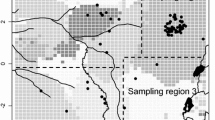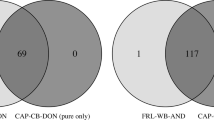Abstract
The endemic Jamaican boa (or “yellow boa”, Epicrates subflavus) is a vulnerable species of the Caribbean biodiversity hotspot whose natural populations greatly declined mainly due to predation by introduced species, human persecution, and habitat destruction. A captive breeding program was initiated in 1976 and rationalized in 2002 by the establishment of a European Endangered Species Program. During the last 30 years, more than 600 offspring, of which 80 are still alive today, have been produced and distributed among European host institutions and privates. Here, using nine nuclear microsatellite loci and a fragment of the mitochondrial cytochrome b gene, we (i) determine the natural population from which the founders originate, (ii) identify parental allocation errors and ambiguities in the studbook, and (iii) assess the genetic diversity and estimate levels of inbreeding of the current captive population based on loss of alleles, variance in reproductive success, and relatedness among individuals. Combining measures of relatedness derived from multilocus genotypes with practical parameters such as age of animals and localization of host institutions, we propose mating groups that would maximize genetic diversity in the captive population of the Jamaican boa. Our analyses provide guidance for a more efficient breeding program that, in turn, could be used as the starting point of a repatriation program to increase the probability of the species long-term survival.




Similar content being viewed by others
References
Bloor PA, Barker FS, Watts PC, Noyes HA, Kemp SJ (2001) Microsatellite libraries by enrichment. University of Liverpool
Brownstein MJ, Carpten JD, Smith JR (1996) Modulation of non-templated nucleotide addition by Taq DNA polymerase: primer modifications that facilitate genotyping. Biotechniques 20:1004–1006, 1008–1010
Ciofi C, Milinkovitch MC, Gibbs JP, Caccone A, Powell J (2002) Microsatellite analysis of genetic divergence among populations of giant Galápagos tortoises. Mol Ecol 11:2265–2283
Coltman DW, Pilkington JG, Smith JA, Pemberton (1999) Parasite-mediated selection against inbred Soay sheep in a free-living island population. Evolution 53:1259–1267
Cornuet JM, Luikart G (1996) Description and power analysis of two tests for detecting recent population bottlenecks from allele frequency data. Genetics 144:2001–2014
Crnokrak P, Barrett SC (2002) Perspective: purging the genetic load: a review of the experimental evidence. Evol Int J Org Evol 56:2347–2358
Duchesne P, Castric T, Bernatchez L (2005) PASOS (parental allocation of singles in open systems): a computer program for individual parental allocation with missing parents. Mol Ecol Notes 5:701–704
Frankham R (1995) Inbreeding and extinction: a threshold effect. Conserv Biol 9:792–799
Frankham R, Ballou JD, Briscoe DA (2004) Introduction to conservation genetics. University Press, Cambridge
Gibson R (1996) The distribution and status of the Jamaican boa Epicrates subflavus (Stejneger, 1901). Dodo J Jersey Wildlife Preserv Trust 32:143–155
Glaubitz JC (2004) CONVERT: a user-friendly program to reformat diploid genotypic data for commonly used population genetic software packages. Mol Ecol Notes 4:309–310
Goodnight KF, Queller DC (1999) Computer software for performing likelihood tests of pedigree relationship using genetic markers. Mol Ecol 8:1231–1234
Gosse PH (1851) A naturalist’s Sojourn in Jamaica. Longman, Brown, Green, and Longmans, London
Goudet J (1995) FSTAT (version 1.2): a computer program to calculate F-statistics. J Hered 86:485–486
Hartl DL, Clark AG (1997) Principles of population genetics, 3rd edn. Sinauer Associates, Sunderland, MA
Hedrick PW, Kalinowski ST (2000) Inbreeding depression in conservation biology. Annu Rev Ecol Syst 31:139–162
Holt WV, Pickard AR, Prather RS (2004) Wildlife conservation and reproductive cloning. Reproduction (Cambridge England) 127:317–324
Lande R, Barrowclough GF (1987) Effective population size, genetic variation, and their use in population management. In: Viable populations for conservation. Cambridge University Press, Cambridge, pp 87–124
Leberg PL, Firmin BD (2008) Role of inbreeding depression and purging in captive breeding and restoration programmes. Mol Ecol 17:334–343
Lively CM, Craddock C, Vrijenhoek R (1990) Red Queen hypothesis supported by parasitism in sexual and clonal fish. Nature 344:864–866
Luikart G, Sherwin WB, Steele BM, Allendorf FW (1998) Usefulness of molecular markers for detecting population bottlenecks via monitoring genetic change. Mol Ecol 7:963–974
Lynn WG, Grant C (1940) The herpetology of Jamaica. Bull Inst Jamaica Sci Ser 1:1–148
Meagher S (1999) Genetic diversity and Capillaria hepatica (Nematoda) prevalence in Michigan deer mouse populations. Evolution 53:1318–1324
Milinkovitch MC, Monteyne D, Gibbs JP, Fritts TH, Tapia W, Snell HL, Tiedemann R, Caccone A, Powell JR (2004) Genetic analysis of a successful repatriation programme: giant Galapagos tortoises. Proc Biol Sci 271:341–345
Milinkovitch MC, Monteyne D, Russello M, Gibbs JP, Snell HL, Tapia W, Marquez C, Caccone A, Powell JR (2007) Giant Galapagos tortoises; molecular genetic analyses identify a trans-island hybrid in a repatriation program of an endangered taxon. BMC Ecol 7:2
Montgomery M, Ballou JD, Nurthen RK, England PR, Briscoe DA, Frankham R (1997) Minimizing kinship in captive breeding programs. Zool Biol 16:377–389
Oliver WLR (1982) The coney and the yellowsnake: the distribution and status of the Jamaican hutia Geocapromys brownii and the Jamaican boa Epicrates subflavus. Dodo J Jersey Wildlife Preserv Trust 19:6–33
Pompanon F, Bonin A, Bellemain E, Taberlet P (2005) Genotyping errors: causes, consequences and solutions. Nat Rev Genet 6:847–859
Queller DC, Goodnight KF (1989) Estimating relatedness using genetic markers. Evolution 43:258–275
Rabinowitz A (1995) Helping a species go extinct: the Sumatran Rhino in Borneo. Conserv Biol 9:482–488
Saccheri I, Kuussaari M, Kankare M, Vikman P, Fortelius W, Hanski I (1998) Inbreeding and extinction in a butterfly metapopulation. Nature 392:491–494
Schretter C, Milinkovitch MC (2006) OligoFaktory: a visual tool for interactive oligonucleotide design. Bioinformatics 22:115–116
Spielman D, Brook BW, Frankham R (2004) Most species are not driven to extinction before genetic factors impact them. Proc Natl Acad Sci 101:15261–15264
Tzika AC, Koenig S, Miller R, Garcia G, Milinkovitch MC (2008) Population structure of an endemic vulnerable species, the Jamaican boa (Epicrates subflavus). Mol Ecol 17:533–544
Wright S (1931) Evolution in Mendelian populations. Genetics 16:97–159
Wyner YM, Amato G, DeSalle R (1999) Captive breeding, reintroduction, and the conservation genetics of black and white ruffed lemurs, Varecia variegata variegata. Mol Ecol 8:S107–S115
Acknowledgements
We thank Les Basford of the Birmingham Nature Center (UK), Ann Williams of the Blackpool Zoo (UK), Gary Watts of the Broxbourne Paradise Wildlife Park (UK), Louise Peat of the Cotswold Wildlife Park (UK), Gwen Fraser of the Chessington World of Adventures (UK), Kevin Buley of the Chester Zoo (UK), Quentin Bloxam and Amy Hall of the Durrell Wildlife Conservation Trust (Jersey, UK), Aleš Toman of the Zoologicka Zohrada Jihlava (Czech Republic), Patricia Vilarinho of the Lisboa Jardim Zoologico (Portugal), Wlodzimierz Stanislawski of the Lodz Miejski Ogrod Zoologiczny (Poland), Richard Gibson of the Zoological Society of London (UK), Mathieu Bufkens and Laurent Vienne of the Musée d’Histoire Naturelle de Tournai (Belgium), and Sergei Ryabov of the Tula Exotarium (Russian Federation) for the samples provided. We thank Marie-Anne Vaesen for technical help. This work was supported by grants from the ‘Communauté Française de Belgique’ (ARC 1164/20022770), the National Fund for Scientific Research Belgium (FNRS), and the Université Libre de Bruxelles. A.C. Tzika is PhD candidate financially supported by the Fonds pour la formation à la Recherche dans l’Industrie et dans l’Agriculture (FRIA), Belgium. Susan Koenig (Windsor Research Center, Jamaica) provided very useful comments on a previous version of the manuscript. The samples are recorded under the import CITES permits 2006BE346-349/PE.
Author information
Authors and Affiliations
Corresponding author
Electronic supplementary material
10592_2008_9519_MOESM1_ESM.doc
Suggested new mating groups of Jamaican boas for the captive breeding program. Groups were designed by minimizing movements among host institutions and relatedness values of each possible females/male pair within groups. The identification numbers of unsampled individuals are shaded and of sub-adults (<6 years old) are underlined. The minimum, maximum, and mean relatedness values within each group are given (na, not applicable). (DOC 36 kb)
Rights and permissions
About this article
Cite this article
Tzika, A.C., Remy, C., Gibson, R. et al. Molecular genetic analysis of a captive-breeding program: the vulnerable endemic Jamaican yellow boa. Conserv Genet 10, 69–77 (2009). https://doi.org/10.1007/s10592-008-9519-z
Received:
Accepted:
Published:
Issue Date:
DOI: https://doi.org/10.1007/s10592-008-9519-z




